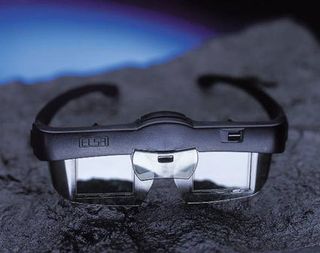3D Stereo Technology: Is it Ready for Prime Time?
3D Shutter Glasses

In the realm of PCs, 3D shutter glasses are probably the best known and most widespread devices used to create a 3D experience. Towards the end of the 1990s, a company called MetaByte caused quite a stir with its shutter glasses, which were sold under the brand name Wicked 3D. Later, Elsa sold these glasses under the 3D Revelator brand. ASUS is another company that bundled its high-end graphics cards with shutter glasses for a period of time.

ASUS VR-100 shutter glasses.
The principle behind shutter glasses is easily explained. As we have touched upon before in this article, each eye needs its own perspective in order to create a 3D effect. This is exactly what shutter glasses ensure, when used in conjunction with a specially adapted graphics driver. The screen alternates between displaying the image/perspective for the right and left eye. Meanwhile, the shutter glasses alternately make the right or left lens opaque, so that only one eye can see the screen.
For this alternating occlusion of the eyes to be unnoticeable, the shuttering has to happen at a high frequency. In practice, the switching cycle is linked to the monitor's refresh rate. If a screen is set to 100 Hz, that means that it draws a scene 100 times every second. However, due to the shuttering effect, the frequency is effectively halved, since each image now consists of two sub-images, namely one for each eye. Consequently, a monitor should at least be capable of running at a refresh rate of 120 Hz, leaving an effective refresh rate of 60 Hz. Obviously, 140 Hz would be even more ergonomic.
Since the shuttering effect is linked to the refresh rate, the shutter glasses need to have some kind of connection with the graphics card to ensure synchronization. The most obvious solution would be a cable, but an infrared connection works as well and offers more comfort.
Shutter glasses only work in conjunction with CRT monitors, since this is the only type of monitor that offers sufficiently high refresh rates. Even modern TFT displays are too slow. Yet even CRT monitors aren't completely problem free. The phosphorescent layer of the screens tends to display a little bit of "afterglow". The result is that each eye sees just a little of the image intended for the other eye, leading to ghosting. This effect is especially pronounced in scenes with high contrast.
Today, shutter glasses have all but vanished from the consumer PC market. Although some models are still being offered, and NVIDIA keeps the 3D stereo driver up to date, there doesn't seem to be a large market for this technology. One factor in this development is surely the proliferation of TFT displays, whose refresh rates are too slow to work properly with shutter glasses.
Stay on the Cutting Edge
Join the experts who read Tom's Hardware for the inside track on enthusiast PC tech news — and have for over 25 years. We'll send breaking news and in-depth reviews of CPUs, GPUs, AI, maker hardware and more straight to your inbox.
Current page: 3D Shutter Glasses
Prev Page Head Mounted Displays (HMDs) Next Page Autostereoscopic DisplaysMost Popular

